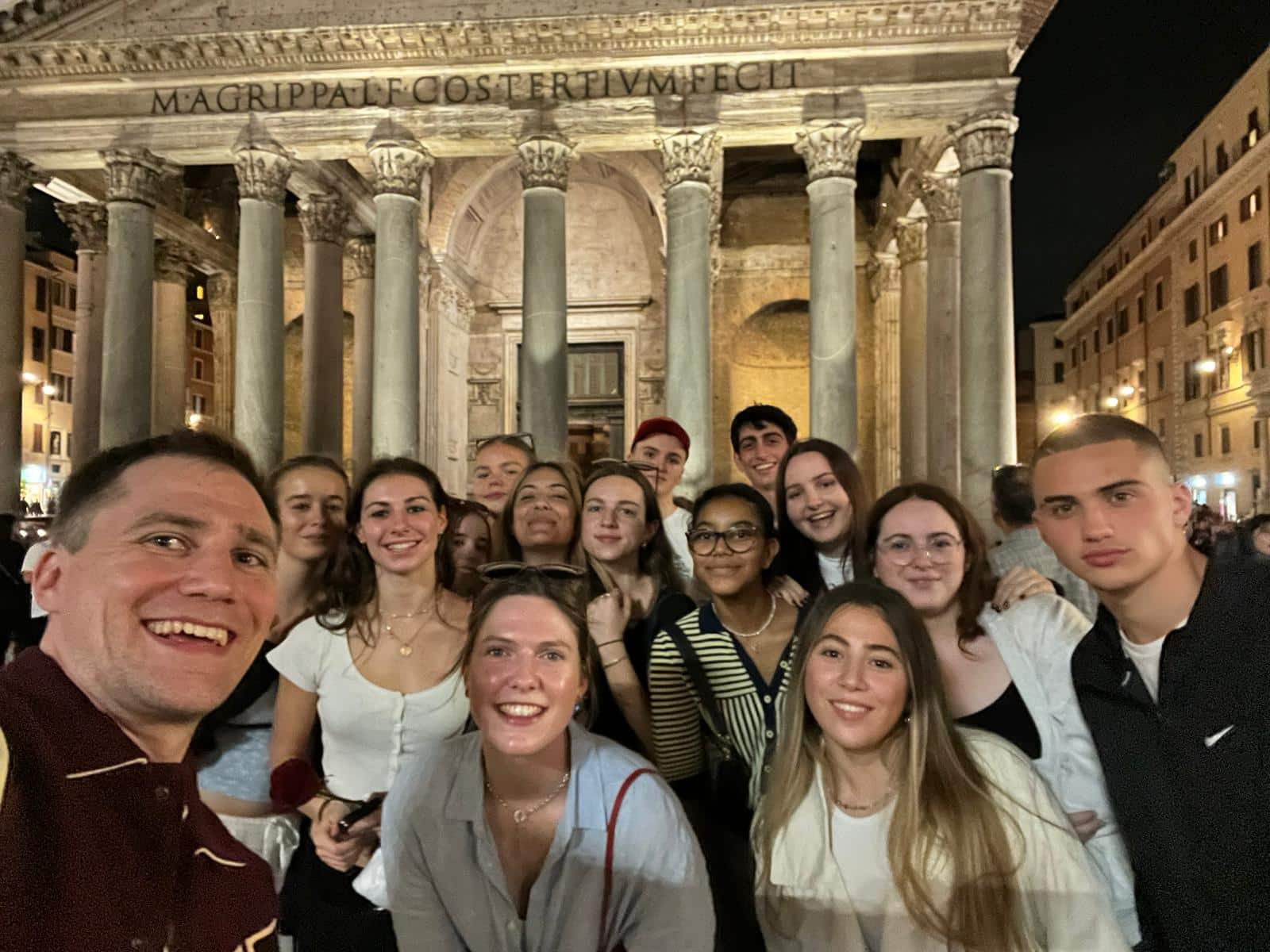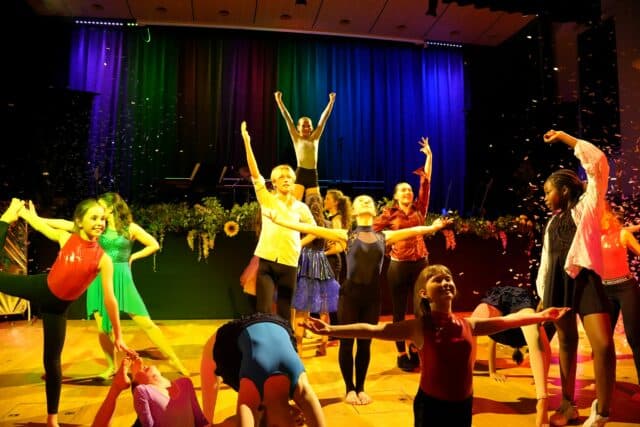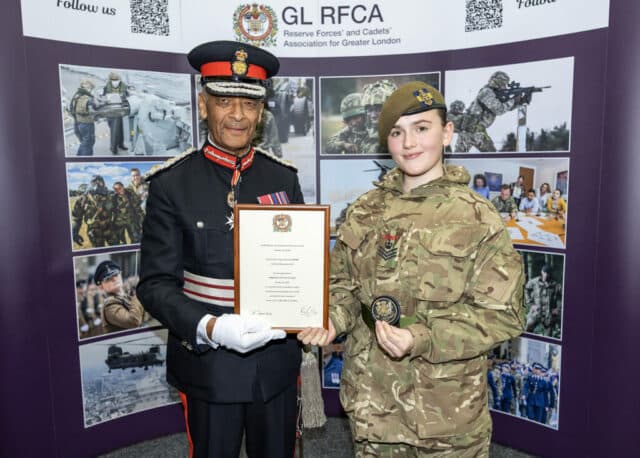Day 1:
A cold, dark, gloomy London morning was brightened by the anticipation of the adventure ahead—an exciting trip to Rome. Upon our arrival in the historic metropolis, we swiftly sought out food. Mr. Greenbury, with his prior experience and knowledge of the city, expertly guided us to a place that could satisfy the hunger of our 16 eager pupils. Various types of pizza were devoured with gusto. We then checked in at ‘Hotel Lux’ and wasted no time before visiting the Pantheon and the Trevi Fountain. The Pantheon, initially a pagan place of worship where soldiers would gather before the war, later transformed into the first Roman church and a place of worship in Christianity within the Roman Empire. The Trevi Fountain was equally spectacular, standing at an impressive 85 feet in height and 65 feet in width, adorned with intricate details and exquisite beauty that left us in awe. We concluded our day with a traditional Italian dinner, marking a perfect end to our first night in Rome.
Day 2:
On the second day, our goal was to explore Vatican City. We embarked on our journey by navigating the metro during rush hour, which, in itself, was an unforgettable experience. Once inside the Vatican Museum, we immersed ourselves in the deep ecclesiastical Roman antiquities. Our knowledgeable guide, Fabio, carefully explained almost every artefact and ancient relic, often emphasizing his favourite and frequently used word of the tour, ‘masterpiece.’ The museum featured numerous ornate rooms, including chiselled busts of key Roman figures and a panoramic view of Rome’s rooftops. The highlight of the museum was the Raphael Rooms, adorned with masterful frescoes and intricate optical illusions, such as painted statues. We learned that Raphael introduced the prominent use of light and dark to contrast his complex religious scenes. Each room took him and his students around four years to complete, showcasing their incredible attention to detail. Subsequently, we made our way to the Sistine Chapel, adorned with the intricately detailed works of Michelangelo. All the walls and the ceiling were decorated with frescoes. We discovered that, by the end of his life, he was nearly blind from the ink dropping onto his eyes while painting the ceiling standing up. One outstanding detail was his use of crushed lapis lazuli to create the blue pigment in the “Last Judgment” painting, creating tonal contrast between the different characters and emphasizing their religious significance. Finally, we visited the magnificent St. Peter’s Basilica, designed by the head architect, Bernini. This extravagant building featured 11 domes dedicated to St. Peter, who is buried in a crypt underneath. We found it beautiful, with mosaic frescoes resembling paintings and an enormous size of approximately 600 yards (twice the size of a football pitch). It boasts the world’s tallest dome, adding to its splendour and is visible from the entrance to Vatican City. We concluded the day by taking the metro to the Spanish Steps, a delightful way to end the day.
Day 3:
The third day focused on the classical aspect of our trip. After taking the significantly less crowded metro, we arrived at the Colosseum. The imposing arches towered above us as we listened to a meticulously researched tour by Kenan Kousetta (Rn) and Andriy Kulba (Rn). We learned about features such as complex underground tunnels and brutal gladiator fights, painting a vivid picture of an ancient Roman experience. From there, we walked up to Palatine Hill, which was scattered with the ruins of once-imposing imperial buildings and offered a panoramic view of the city. Olivia Rodriguez (Wh) and Lucie Jordan (M) provided us with insights into the rich history and mythology surrounding the hill, including the founding of Rome by Romulus. Our next stop was the Forum, guided by Lily Graves (Wh), Arabella Alderman (Wh), Kimberly Costa (W), and Tilly Hollands (Wh). The Forum, once a bustling city centre, is now covered in temple ruins and ornate arches. Highlights included the Arch of Septimius Severus, and the Temple dedicated to Antonius Pius and Faustina, accompanied by an informative talk about the myths and history surrounding the location. Unfortunately, an extended lunch break was necessitated by adverse weather conditions, postponing our anticipated visit to the Baths of Caracalla until the following morning. The outing concluded at the Capitol Museum, where we saw several well-known pieces. The bronze statue of Marcus Aurelius on a horse and the colossal bust of Constantine left a lasting impression (It was indeed colossal). After an eventful metro ride back to the hotel, we enjoyed our final dinner as a group in Rome.
Day 4:
The last day in Rome began with a final inspirational lecture from Mr Greenbury, outlining the busy plan for the day. To start, we arrived at the Circus Maximus, an exciting first venture into the history of the Roman Empire. This vast arena could accommodate 250,000 Romans, who came together to enjoy a horse racing spectacle performed by talented slaves. The race consisted of seven laps, with charioteers dangerously racing around the track. Our next stop was The Central Baths at Caracalla, where Sophie Brittian (Rv), Sophie Clark (Rv), and Annabella Hibbert (Rv) presented the rest of the group with a tour based on research they had conducted the day before. We were able to experience first-hand the places where the Romans washed and relaxed. We discovered that the Romans had a great understanding of both heat and cleanliness. They knew that you had to go into a warm room to open your pores and then go into a cold one to close them again. They also understood how to transfer heat through a boiler system in Rome. Next, we went to the National Museum of Rome, where we saw many fascinating ancient artefacts, including the Discobolus, a sculpture depicting a discus thrower. Finally, we visited the Catacombs, a network of underground tunnels containing former burial grounds that date from the second to the fifth century. These catacombs were used by Christians, Jews, and Romans. The Christians abstained from the pagan tradition of cremating the bodies of the deceased. To address challenges arising from limited space and high land costs, they opted to establish these extensive underground cemeteries. This was our final cultural visit in Rome, and from here we headed to the airport to head home. Despite a jovial time playing the piano inside the airport during our nearly 2-hour delay, we embarked on the aircraft excited to be returning home, only for the pilot to stop at the start of the runway to inform us that we would not be taking off from Rome that evening due to a technical fault with the aircraft. After a hectic couple of hours, we finally managed to locate a hotel that would accept us, around 10 miles from the airport. After a rather speedy taxi ride on empty Roman motorways at 3:00 a.m., we hunkered down at our destination. After only a few hours of sleep, we headed back to Leonardo da Vinci–Fiumicino Airport, where this time, we managed to leave the runway and touch down back at Gatwick airport. Without the successful efforts of Mr. Greenbury and Ms. Greenbury, I doubt we would have arrived home as soon as we did!
In summary, the trip left a profound and lasting impact, offering both education and enjoyment. It undeniably created lifelong memories. I would like to express my sincere gratitude to Mr Greenbury and Ms Greenbury for their exceptional organization, planning, and skilful management of the trip. They not only ensured our safety but also made sure we had a memorable experience in Rome. Their valuable insights, particularly their knowledge of local pizzerias, were well received and were indeed as exceptional as they had described. Without them, the trip would most definitely not have been as amazing as it was.
Kenan Kousetta, Upper Sixth





